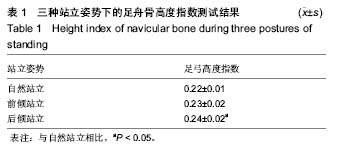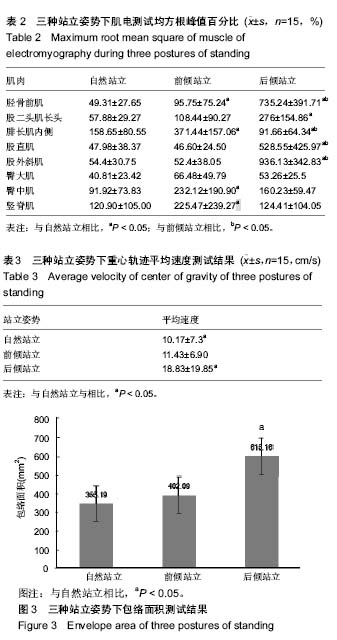中国组织工程研究 ›› 2019, Vol. 23 ›› Issue (15): 2345-2349.doi: 10.3969/j.issn.2095-4344.1145
• 肌肉肌腱韧带组织构建 tissue construction of the muscle, tendon and ligament • 上一篇 下一篇
不同姿势站立时人体的平衡能力及足型特征
朱瑶佳1,霍洪峰1,2
- (1河北师范大学体育学院,河北省石家庄市 050024;2河北省人体运动生物信息测评重点实验室,河北省石家庄市 050024)
Balance ability and foot type characteristics during different postures of standing
Zhu Yaojia1, Huo Hongfeng1, 2
- 霍洪峰,硕士,高级实验师,河北省人体运动生物信息测评重点实验室,河北省石家庄市 50024
摘要:
文章快速阅读:
.jpg)
文题释义:
踝关节策略:是指中枢神经系统通过激活踝关节周围的肌肉来平衡恢复矫正力矩,即使用踝关节稳定身体的策略。当身体扰动较小时,通过踝关节策略进行细微控制达到身体平衡。
包络面积:是指人体重心摆动轨迹所覆盖的的区域面积,可以反映出人体平衡障碍的程度。
.jpg)
文题释义:
踝关节策略:是指中枢神经系统通过激活踝关节周围的肌肉来平衡恢复矫正力矩,即使用踝关节稳定身体的策略。当身体扰动较小时,通过踝关节策略进行细微控制达到身体平衡。
包络面积:是指人体重心摆动轨迹所覆盖的的区域面积,可以反映出人体平衡障碍的程度。
摘要
背景:站立时身体重心的改变反映了下肢乃至全身的结构、功能和肌肉等方面的信息。站立姿势控制与足型、平衡能力、肌肉激活程度之间关系的研究不足。
目的:探讨自然站立、前倾站立、后倾站立对足弓、身体平衡和肌肉激活程度的影响。
方法:选取受试者15名,均无足部病变和影响足部功能相关的疾病。使用三维足型扫描仪对3种站立姿势下的足弓进行测试与分析、使用BTS FREEMG 300无线表面肌电测试仪、平衡测力台对3种站立姿势下肌肉均方根最大值、2个平衡能力指标(包络面积、重心平均速度)进行测试与分析。
结果与结论:①足弓高度指数:自然站立与前倾站立对比时差异有显著性意义(P < 0.05),自然站立与后倾站立对比时差异有显著性意义(P < 0.05),前倾站立与后倾站立对比时差异无显著性意义(P > 0.05);②肌肉激活程度由大到小:自然站立时依次为腓长肌内侧、竖脊肌、腹直肌、臀中肌、股二头肌长头、股外斜肌、胫骨前肌、股直肌、臀大肌;前倾站立时依次为腓长肌内侧、臀中肌、竖脊肌、股二头肌长头、胫骨前肌、腹直肌、臀大肌、股外斜肌、股直肌;后倾站立时依次为股外斜肌、胫骨前肌、股直肌、股二头肌长头、竖脊肌、腹直肌、腓长肌内侧、臀中肌、臀大肌;③平衡:自然站立与前倾站立对比差异无显著性意义(P > 0.05),自然站立与后倾站立对比差异有显著性意义(P < 0.05),而前倾站立与后倾站立对比差异无显著性意义(P > 0.05);④结果说明,人体自然站立时可以在低肌肉激活强度下轻松维持身体稳定,身体后倾时,由于不稳定造成肌肉激活强度最高,身体重心向前、后移动时主要激活对侧肌肉;足弓在身体前倾和后倾时较自然站立时升高;站立姿势下重心轻微的前后移动都会导致肌肉激活程度和平衡控制的变化。
中国组织工程研究杂志出版内容重点:组织构建;骨细胞;软骨细胞;细胞培养;成纤维细胞;血管内皮细胞;骨质疏松;组织工程
ORCID: 0000-0001-7359-1137(朱瑶佳)
背景:站立时身体重心的改变反映了下肢乃至全身的结构、功能和肌肉等方面的信息。站立姿势控制与足型、平衡能力、肌肉激活程度之间关系的研究不足。
目的:探讨自然站立、前倾站立、后倾站立对足弓、身体平衡和肌肉激活程度的影响。
方法:选取受试者15名,均无足部病变和影响足部功能相关的疾病。使用三维足型扫描仪对3种站立姿势下的足弓进行测试与分析、使用BTS FREEMG 300无线表面肌电测试仪、平衡测力台对3种站立姿势下肌肉均方根最大值、2个平衡能力指标(包络面积、重心平均速度)进行测试与分析。
结果与结论:①足弓高度指数:自然站立与前倾站立对比时差异有显著性意义(P < 0.05),自然站立与后倾站立对比时差异有显著性意义(P < 0.05),前倾站立与后倾站立对比时差异无显著性意义(P > 0.05);②肌肉激活程度由大到小:自然站立时依次为腓长肌内侧、竖脊肌、腹直肌、臀中肌、股二头肌长头、股外斜肌、胫骨前肌、股直肌、臀大肌;前倾站立时依次为腓长肌内侧、臀中肌、竖脊肌、股二头肌长头、胫骨前肌、腹直肌、臀大肌、股外斜肌、股直肌;后倾站立时依次为股外斜肌、胫骨前肌、股直肌、股二头肌长头、竖脊肌、腹直肌、腓长肌内侧、臀中肌、臀大肌;③平衡:自然站立与前倾站立对比差异无显著性意义(P > 0.05),自然站立与后倾站立对比差异有显著性意义(P < 0.05),而前倾站立与后倾站立对比差异无显著性意义(P > 0.05);④结果说明,人体自然站立时可以在低肌肉激活强度下轻松维持身体稳定,身体后倾时,由于不稳定造成肌肉激活强度最高,身体重心向前、后移动时主要激活对侧肌肉;足弓在身体前倾和后倾时较自然站立时升高;站立姿势下重心轻微的前后移动都会导致肌肉激活程度和平衡控制的变化。
中国组织工程研究杂志出版内容重点:组织构建;骨细胞;软骨细胞;细胞培养;成纤维细胞;血管内皮细胞;骨质疏松;组织工程
ORCID: 0000-0001-7359-1137(朱瑶佳)
中图分类号:



.jpg)
.jpg)
.jpg) #br#
文题释义:#br#
踝关节策略:是指中枢神经系统通过激活踝关节周围的肌肉来平衡恢复矫正力矩,即使用踝关节稳定身体的策略。当身体扰动较小时,通过踝关节策略进行细微控制达到身体平衡。#br#
包络面积:是指人体重心摆动轨迹所覆盖的的区域面积,可以反映出人体平衡障碍的程度。#br#
#br#
#br#
文题释义:#br#
踝关节策略:是指中枢神经系统通过激活踝关节周围的肌肉来平衡恢复矫正力矩,即使用踝关节稳定身体的策略。当身体扰动较小时,通过踝关节策略进行细微控制达到身体平衡。#br#
包络面积:是指人体重心摆动轨迹所覆盖的的区域面积,可以反映出人体平衡障碍的程度。#br#
#br#